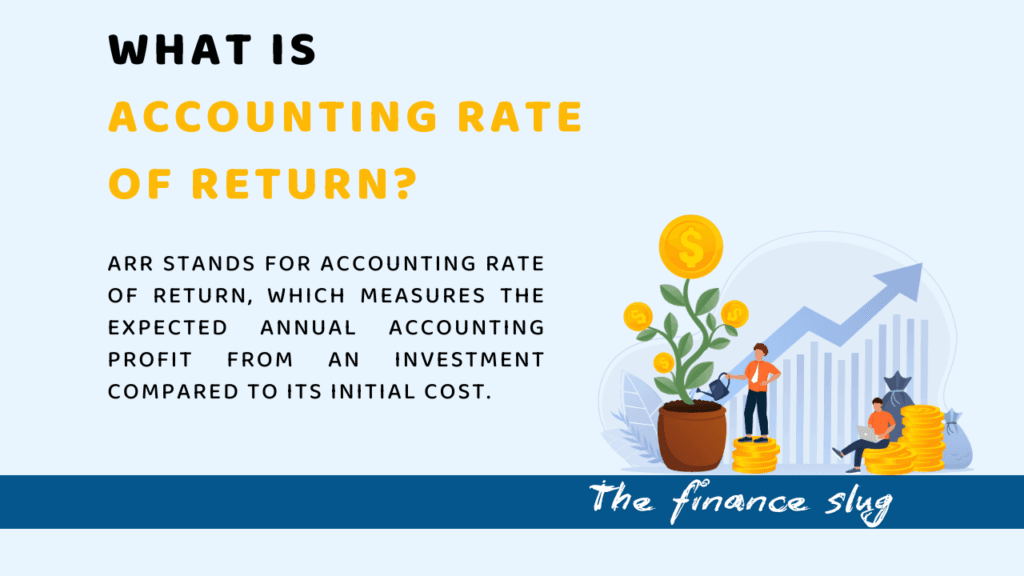
The Accounting Rate of Return (ARR) is a financial metric businesses use to evaluate the profitability of their investments. ARR is simple to calculate and gives a clear percentage return based on accounting profits. It is widely used to make quick decisions on whether an investment is worth pursuing.
What is ARR?
ARR stands for Accounting Rate of Return, which measures the expected annual accounting profit from an investment compared to its initial cost. Unlike other methods like Net Present Value (NPV) or Internal Rate of Return (IRR), ARR focuses solely on profits recorded in the company’s books, making it a straightforward and easy-to-understand tool.
how to calculate Accounting Rate of Return?
To calculate the ARR, use this formula:
ARR=(Average Annual Accounting ProfitInitial Investment)×100
- Average Annual Accounting Profit: The profit after deducting expenses, taxes, and depreciation.
- Initial Investment: The total cost of the project or asset.
Example:
Suppose a business invests $100,000 in a project and expects an annual profit of $20,000. The ARR would be:
ARR=(20,000/100,000)×100=20%
This means the investment yields a 20% return annually.
Key Benefits of ARR
- Simplicity: ARR is easy to calculate and interpret.
- Comparison Tool: It helps compare the profitability of multiple projects or investments.
- Focus on Accounting Profits: ARR provides insights into the financial performance visible in the company’s income statement.
Limitations of ARR
- Ignores Cash Flow: ARR does not consider actual cash inflows or outflows.
- Time Value of Money: ARR overlooks the fact that money today is worth more than the same amount in the future.
- Depreciation Impact: Since ARR relies on accounting profits, changes in depreciation methods can affect the results.
ARR vs. RRR: Key Differences
When evaluating investments, businesses often compare the Accounting Rate of Return (ARR) with the Required Rate of Return (RRR). While both are essential financial metrics, they serve different purposes in decision-making.
- ARR measures the expected annual profit as a percentage of the initial investment. It focuses on accounting profits and helps businesses quickly assess profitability.
- RRR, or the Required Rate of Return, is the minimum return an investor expects to earn from an investment. It factors in risks, opportunity costs, and market conditions.
The main difference is that ARR focuses on accounting data, while RRR evaluates if an investment meets a company’s profitability threshold based on risk and expected returns.
When Should You Use ARR?
ARR is ideal for businesses seeking a quick way to assess an investment’s profitability, especially for projects where detailed cash flow analysis is unnecessary. However, it’s often used alongside other financial metrics for a more comprehensive evaluation.
FAQ: Common Questions About Accounting Rate of Return (ARR)
1. What is the difference between IRR and ARR?
The Internal Rate of Return (IRR) focuses on cash flows generated by an investment over its lifetime and accounts for the time value of money. In contrast, ARR is based on accounting profits and ignores the time value of money. IRR is more detailed and complex, while ARR is simpler and suitable for quick assessments.
2. Is a higher accounting rate of return good?
Yes, a higher ARR is generally considered better because it indicates greater profitability. However, ARR alone may not provide a complete picture. It’s important to compare ARR with the company’s Required Rate of Return (RRR) and use other metrics like NPV or IRR for a comprehensive analysis.
3. What is the difference between the payback period and the accounting rate of return?
The payback period measures the time required to recover the initial investment, focusing on speed rather than profitability. ARR evaluates profitability by comparing the average annual accounting profit to the initial investment. While the payback period is expressed in years or months, ARR is expressed as a percentage. Both methods ignore the time value of money but serve different purposes.
Conclusion
The Accounting Rate of Return is a straightforward metric that simplifies investment analysis. While it has limitations, such as ignoring cash flows and the time value of money, it remains a valuable tool for quick profitability comparisons.
By understanding ARR and how it compares with other metrics like RRR, IRR, or the payback period, businesses can make smarter investment decisions that align with their financial goals.
Also Read>>>
Accredited Asset Management Specialist (AAMS): Everything You Need to Know
Accounts Receivable Financing: What It Is & How It Works
Accounts Receivable Aging: Definition, Importance & Best Practices
What is Accounts Receivable (AR)? Definition, Examples & Best Practices
Accounts Payable Turnover Ratio: Formula, Importance & Calculation
Accounts Payable (AP) Explained: Definition, Process & Best Practices
Article Source: Economic and Accounting Rates of Return







